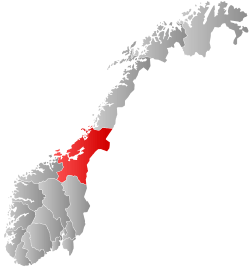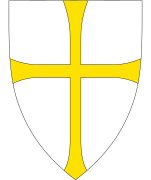Agdenes
| Agdenes kommune | |||
|---|---|---|---|
| Municipality | |||
| |||
 Agdenes within Trøndelag | |||
| Coordinates: 63°32′05″N 09°42′04″E / 63.53472°N 9.70111°ECoordinates: 63°32′05″N 09°42′04″E / 63.53472°N 9.70111°E | |||
| Country | Norway | ||
| County | Trøndelag | ||
| District | Orkdalen | ||
| Established | 1 Jan 1896 | ||
| Administrative centre | Selbekken | ||
| Government | |||
| • Mayor (1995) | Oddvar Indergård (Felleslista for bygdeutvikling) | ||
| Area | |||
| • Total | 317.29 km2 (122.51 sq mi) | ||
| • Land | 296.52 km2 (114.49 sq mi) | ||
| • Water | 20.77 km2 (8.02 sq mi) 6.5% | ||
| Area rank | #270 in Norway | ||
| Population (2017) | |||
| • Total | 1,711 | ||
| • Rank | #342 in Norway | ||
| • Density | 5.8/km2 (15/sq mi) | ||
| • Change (10 years) | -3.6% | ||
| Demonym(s) |
Agdenesing Lensvikbygg[1] | ||
| Time zone | UTC+01:00 (CET) | ||
| • Summer (DST) | UTC+02:00 (CEST) | ||
| ISO 3166 code | NO-5016 | ||
| Official language form | Bokmål | ||
| Website |
agdenes | ||
Agdenes is a municipality in Trøndelag county, Norway. It is part of the Fosen region. The administrative centre is the village of Selbekken. Other villages in the municipality include Ingdalen, Lensvik, Vassbygda, Vernes, and Leksa.[2] The Brekstad–Valset Ferry connects Agdenes to the town of Brekstad in Ørland municipality on the other side of the Trondheimsfjorden.
The 317-square-kilometre (122 sq mi) municipality is the 270th largest by area out of the 422 municipalities in Norway. Agdenes is the 342nd most populous municipality in Norway with a population of 1,711. The municipality's population density is 5.8 inhabitants per square kilometre (15/sq mi) and its population has decreased by 3.6% over the last decade.[3]
General information
The municipality of Værnes was established on 1 January 1896 when it was separated from the large municipality of Ørland which originally included land on both sides of the mouth of the Trondheimsfjorden. The new municipality of Værnes encompassed the area along the south side of the Trondheimsleia and Trondheimsfjorden and it initially had a population of 1,412. The name was changed to Agdenes on 17 May 1897 by a royal resolution. The administrative centre was originally at the village of Værnes where the Agdenes Church is located.
During the 1960s, there were many municipal mergers across Norway due to the work of the Schei Committee. On 1 January 1964, the western part of Agdenes (Ytre Agdenes) was separated from the rest of the municipality and it was merged with the neighboring municipalities of Snillfjord (population: 681) and Heim (population: 724) to form the new municipality of Snillfjord. On the same date, the rest of Agdenes municipality (population: 858) was merged with the neighboring municipalities of Lensvik (population: 1,136) and the Ingdalen area of Stadsbygd (population: 171) and together, they formed a new, larger municipality of Agdenes.
On 1 January 1995, the Moldtun area (population: 21) was transferred from Agdenes to the neighboring municipality of Snillfjord. This transfer was approved because the area had been without an outside road connection, and so the only connection was by boat which made it very close to the village of Vernes in Agdenes. When the road was built, it was built to the west, connecting it to Snillfjord, not Agdenes. Therefore, it was logical for the residents to vote to change municipalities.[4]
On 1 January 2018, the municipality switched from the old Sør-Trøndelag county to the new Trøndelag county. On 1 January 2020, the municipalities of Agdenes, Orkdal, and Meldal along with the majority of Snillfjord will be merged to form the new municipality of Orkland.[5]
Name
The municipality (originally the parish) is named after the old Agdenes farm (Old Norse: Agðanes), since the first Agdenes Church was built there. The meaning of the first element is unknown (but it is probably the same meaning as in the name Agder) and the last element is nes which means "headland".[6]
Coat of arms
The coat of arms is from modern times. They were granted on 30 August 1991. The arms show a field of ermine under a red chief. The ermine field symbolizes the fur farming in the municipality. As ermine is also a royal symbol, it symbolises the fact that in historical times the local overlords (jarls) and kings have resided in the village. The red chief across the top was chosen to represent the importance of strawberry farming in the municipality.[7]
Churches
The Church of Norway has one parish (sokn) within the municipality of Agdenes. It is part of the Orkdal prosti (deanery) in the Diocese of Nidaros.
| Parish (Sokn) | Church Name | Location of the Church | Year Built |
|---|---|---|---|
| Agdenes | Agdenes Church | Vernes | 1857 |
| Lensvik Church | Lensvik | 1863 | |
| Ingdal Chapel | Ingdalen | 1960 |
Economy
The industrial density of Agdenes is above the national average, and the primary sector is the biggest. Most of the inhabitants work within the milk or forest industry. The growth of strawberries and the breeding of fur animals are important industries as well.
The growth of strawberries has been a major industry in Agdenes for the past 100 years, started by the farmer Lars H. Selbæk in 1886 by planting some strawberry flowers and then giving them away to neighbouring farms. The most common varieties of strawberry grown here are Korona, Sephyr, Senga Sengana, and Bounty. Today, strawberry collection is performed by foreign workers, which are mainly from Poland and Lithuania. In the initial stages, the Norwegian youth were the main workforce, but after the 1970s, it became less attractive for them to pick strawberries in a field.
Government
All municipalities in Norway, including Agdenes, are responsible for primary education (through 10th grade), outpatient health services, senior citizen services, unemployment and other social services, zoning, economic development, and municipal roads. The municipality is governed by a municipal council of elected representatives, which in turn elect a mayor. The municipality falls under the Sør-Trøndelag District Court and the Frostating Court of Appeal.
Municipal council
The municipal council (Kommunestyre) of Agdenes is made up of 17 representatives that are elected every four years. Currently, the party breakdown is as follows:[8]
| Party Name | Name in Norwegian | Number of representatives | |
|---|---|---|---|
| Labour Party | Arbeiderpartiet | 3 | |
| Conservative Party | Høyre | 2 | |
| Centre Party | Senterpartiet | 2 | |
| Local Lists | Lokale lister | 10 | |
| Total number of members: | 17 | ||
Geography

The municipality is situated at the south end of the mouth of the Trondheimsfjord where it meets the Trondheimsleia. It includes several islands including Leksa. The municipality borders the municipalities of Hitra, Ørland, Indre Fosen, Orkdal, and Snillfjord. The lake Øyangsvatnet is located in the west central part of the municipality. The Agdenes Lighthouse sits on the edge of the Trondheimsfjord.
Birdlife
The municipality of Agdenes has a rich and varied birdlife. One of the better places is Litlvatnet. Fully protected since 1983, this nature reserve comprises shallow water with extensive reed beds. The lake is surrounded by farm land, which in its own right provides food and shelter for several species. Formed during the last ice age when sea levels dropped leaving exposed areas of land and trapped water from the melting ice, today's Litlvatnet is a remnant of this.
References
- ↑ "Navn på steder og personer: Innbyggjarnamn" (in Norwegian). Språkrådet. Retrieved 2015-12-01.
- ↑ Haugen, Morten, ed. (2017-10-19). "Agdenes". Store norske leksikon (in Norwegian). Kunnskapsforlaget. Retrieved 2018-02-10.
- ↑ Statistisk sentralbyrå (2017). "Table: 06913: Population 1 January and population changes during the calendar year (M)" (in Norwegian). Retrieved 2017-10-02.
- ↑ Jukvam, Dag (1999). "Historisk oversikt over endringer i kommune- og fylkesinndelingen" (PDF) (in Norwegian). Statistisk sentralbyrå.
- ↑ "Nye Orkland: Kommunene" (in Norwegian). Retrieved 2017-10-02.
- ↑ Rygh, Oluf (1901). Norske gaardnavne: Søndre Trondhjems amt (in Norwegian) (14 ed.). Kristiania, Norge: W. C. Fabritius & sønners bogtrikkeri. p. 42.
- ↑ Norske Kommunevåpen (1990). "Nye kommunevåbener i Norden". Retrieved 25 October 2008.
- ↑ "Table: 04813: Members of the local councils, by party/electoral list at the Municipal Council election (M)" (in Norwegian). Statistics Norway. 2015. Archived from the original on 2016-03-06.
External links
| Wikimedia Commons has media related to Agdenes. |

- Municipal fact sheet from Statistics Norway (in Norwegian)


